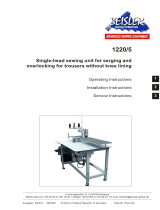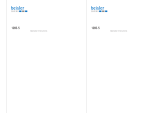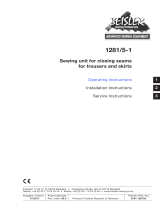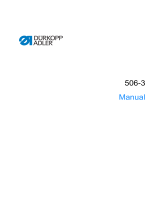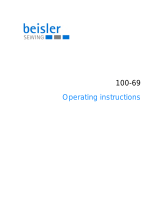Page is loading ...

100 - 69
Operating manual

All rights reserved.
Property of Dürkopp Adler AG and protected by copyright. Reproduction or publication of the
content in any manner, even in extracts, without prior written permission of Dürkopp Adler AG,
is prohibited.
Copyright © Dürkopp Adler AG - 2013

Table of contents
Operating manual 100-69 version 00.0 - 05/2013
1
1 About this operating manual ..................................................... 3
1.1 Scope of application of the operating manual............................... 3
1.2 For whom is this operating manual?............................................. 3
1.3 Conventions of representation– Symbols and characters ............ 4
1.4 Other documents .......................................................................... 4
1.5 Liability.......................................................................................... 4
1.5.1 Transportation............................................................................... 5
1.5.2 Designated use............................................................................. 5
2 Performance description ........................................................... 7
2.1 Features........................................................................................ 7
2.2 Declaration of conformity.............................................................. 8
2.3 Optional equipment....................................................................... 9
2.4 Technical data ............................................................................ 13
3 Safety instructions ................................................................... 15
3.1 Basic safety instructions ............................................................. 15
3.2 Signal words and symbols used in warnings .............................. 16
4 Machine description 100-69..................................................... 19
4.1 Sewing unit ................................................................................. 19
4.2 Software description ................................................................... 20
5 Operation................................................................................... 21
5.1 Working methods........................................................................ 21
5.1.1 Working method "Production of trousers"................................... 22
5.1.2 Working method “Breast welt pocket".........................................24
5.2 Swing the folding station aside. .................................................. 26
5.3 Removing the fabric sliding sheet............................................... 28
5.4 Needles and threads................................................................... 29
5.4.1 Recommended yarns.................................................................. 29
5.4.2 Changing the needles................................................................. 31
5.5 Threading in the needle thread................................................... 32
5.6 Winding on the looper thread...................................................... 33
5.7 Residual thread monitor.............................................................. 34
5.8 Slanted pocket opening (optional) .............................................. 35
5.8.1 Swinging the corner knife station out / in................................... 35
5.8.2 Setting the corner knife............................................................... 37
5.9 Sewing procedure....................................................................... 38
5.9.1 Switching on ............................................................................... 38
5.9.2 Reference position...................................................................... 39
5.9.3 Starting the sewing cycle............................................................ 40
5.9.4 EMERGENCY stop..................................................................... 40
5.9.5 Switching off ............................................................................... 41
5.10 Quick clamp adjustment/folder monitoring.................................. 41
5.11 Functions/operation of the optional equipment........................... 43
5.11.1 Tape feed unit............................................................................. 43
5.11.2 Device for endless zippers.......................................................... 45
5.11.3 Downholder and Pocket bag clamp............................................ 46
5.11.4 Stacker........................................................................................ 47
5.11.5 Roll-off device............................................................................. 51
5.11.6 Blow-out device .......................................................................... 52
5.11.7 Bundle clamp.............................................................................. 53
5.12 Maintenance ............................................................................... 55
5.12.1 Cleaning...................................................................................... 55
5.12.2 Oil level control ........................................................................... 57

Table of contents
Operating manual 100-69 version 00.0 - 05/2013
2
6 Set-up......................................................................................... 59
6.1 Delivery scope ............................................................................ 59
6.2 Installing the sewing unit............................................................. 60
6.2.1 Transportation............................................................................. 60
6.2.2 Removing the transport securing devices................................... 61
6.2.3 Setting the working height .......................................................... 62
6.3 Attaching the machine parts removed for shipping..................... 63
6.3.1 Attaching the thread reel holder.................................................. 63
6.3.2 Mounting the control panel ......................................................... 63
6.3.3 Fixing the winder......................................................................... 64
6.3.4 Table extensions (optional equipment)....................................... 64
6.4 Electrical connection................................................................... 66
6.4.1 Connecting the control panel DACIII .......................................... 66
6.4.2 Connecting a separate winder.................................................... 67
6.4.3 Checking the nominal voltage and connecting to the mains....... 67
6.4.4 Checking the nominal voltage of the vacuum device.................. 68
6.4.5 Direction of rotation of the sewing motor and the vacuum blower ..
68
6.5 Pneumatic connection ................................................................ 69
6.6 Conncetion to the in-house vacuum unit .................................... 71
6.7 Oil lubrication.............................................................................. 72
6.8 Putting into operation.................................................................. 73
6.9 Installation of the software.......................................................... 75
6.10 Customer service........................................................................ 77
7 Decommissioning..................................................................... 79
8 Disposal..................................................................................... 81

About this operating manual
Operating manual 100-69 version 00.0 - 05/2013
3
1 About this operating manual
The operating manual for the 100-69 sewing unit was compiled with the
utmost care. It contains information and notes in order to make long-term
and reliable operation possible.
Should you notice any discrepancies or if you have improvement re-
quests, then we would be glad to receive your feedback, chapter 6.10
Customer Service.
Please regard the operating manual as part of the product and keep it in
a safe place where it can be easily accessed. Read the operating manual
completely prior to using the unit for the first time. Only pass the product
on to third parties together with the operating manual.
1.1 Scope of application of the operating manual
This operating manual describes the set-up and intended use of the
100-69 sewing unit.
1.2 For whom is this operating manual?
The operating manual is intended for:
• Machine operaters:
This group of employees has been trained in operating the machine
and can access the operating manual. Specifically chapter 5 of
the Operating Manual is important for this group of employees.
• Technicians:
This group of employees has the appropriate technical training
allowing them to perform maintenance on the sewing unit or to repair
faults. Specifically chapter 6 of the Set-up Instructions is import-
ant for this specialized staff.
Service instructions are supplied separately.
With regard to minimum qualification and other requirements to be met by
the personnel, please also observe chapter 3 of the Safety Instructions.

About this operating manual
Operating manual 100-69 version 00.0 - 05/2013
4
1.3 Conventions of representation– Symbols and characters
Different information is depicted or highlighted in this operating manual by
the following characters for easier and quicker understanding:
Safety Important warnings for the user of the machine are specifically marked.
Because safety constitutes an area of major importance, hazard symbols,
levels of risk, and their signal words are described separately in chap-
ter 3 of the Safety Instructions.
Location
information
Information on where something is positioned using the terms "right" or
"left" must always be regarded from the operator's point of view if the fig-
ure gives no other obvious indication for determining the location.
1.4 Other documents
The device contains built-in components from other manufacturers. The
respective manufacturers have carried out hazard assessments for these
purchased parts and confirmed compliance of the design with the applica-
ble European and national regulations. The intended use of the built-in
components is described in the corresponding manuals of the manufac-
turers.
1.5 Liability
All information and notes in this operating manual have been compiled in
accordance with the latest technology and the applicable standards and
regulations.
The manufacturer cannot be held liable for any damage due to:
• Damage during transport
• Failure to observe the operating manual
• Improper use
• Unauthorized modifications to the machine
• The deployment of untrained personnel
• Using spare parts not approved
Symbol/character Meaning
•
Lists are identified by bullet points.
1.
2.
Instructions are numbered and have to be performed in the
specified order.
References to further information in this operating manual or
other documents are identified by this symbol.

About this operating manual
Operating manual 100-69 version 00.0 - 05/2013
5
1.5.1 Transportation
Dürkopp Adler cannot be held liable for any damage during transport.
Check the delivered product immediately after receiving it. Report any
damage to the last transport manager. This also applies if the packaging
is not damaged.
Keep the machines, devices and packaging material in the condition they
were at the time when the damage was identified. That secures any claims
towards the transport company.
Report all other complaints to Dürkopp Adler immediately after receiving
the product.
1.5.2 Designated use
The Beisler 100-69 is a sewing unit designated for the sewing of light to
medium-weight material. Such material is generally made of textile fibers,
composite materials but it may also consist of leather. These materials are
used in the garment industry.
In general only dry material must be sewn on this machine. The material
must not contain any hard objects.
The seam is generally sewn with core thread, polyester fiber or cotton
thread.
The dimensions for needle and hook threads can be taken from the table
in chapter 5.4.
Before using any other threads it is necessary to estimate the consequen-
tial dangers and to take the respective safety measures, if required.
The machine may only be set up and operated in dry conditions on well-
maintained premises. If the machine is operated on premises that are not
dry and well-maintained, then further measures may be required which
must be compatible with EN 60204-31:1999.
Only authorized/trained persons may work on the machine.
The manufacturer will not be held liable for damage resulting from improp-
er use.
Danger due to high voltage, crushing and
sharp objects.
Improper use can result in injuries.
Please follow all instructions given in the manual.
WARNING
Improper use could result in material damage.
Please follow all instructions given in the manual.
ATTENTION

About this operating manual
Operating manual 100-69 version 00.0 - 05/2013
6

Performance description
Operating manual 100-69 version 00.0 - 05/2013
7
2 Performance description
The 100-69 is a sewing unit for the runstitching of piped pocket, flap pock-
et and welt pocket openings with rectangular or slanted pocket corners.
2.1 Features
The Beisler 100-69 is a sewing unit for automated runstitching of piped
pocket, flap pocket and welt pocket openings with rectangular or slanted
pocket corners.
The slanted pocket corners result from the offset of the two seam rows. It
is possible to sew different slants at the seam beginning and at the seam
end.
Depending on the working method different feeding devices, corner knife
stations and optional equipments are used.
Machine head
• Twin needle lockstitch version
• Needle bars can be switched separately
• Vertical hook
• Externally driven center knife, speed and circuit timing programmable
• Thread trimming device for needle and hook threads
• Needle thread monitor
• Photoelectric remaining thread monitor for the hook threads
• DC direct sewing drive
Step motors for the material feed and the length adjustment of the
corner trimming device
The step motor technology allows short machine times and guarantees an
absolutely precise material feed and accurate corner incisions. Thus, it
contributes to an unequalled pocket quality combined with high productiv-
ity.
New control generation “DAC III”
The graphic user guidance exclusively occurs via internationally compre-
hensible symbols and text lines in the corresponding language. The vari-
ous symbols are combined in groups within the menu structure of the
sewing and test programs. The user-friendly operation cuts short training
times.
20 storage locations with each 6 seam programs are available. Thus it is
possible to generate and store up to 6 different seam programs per stor-
age location. Each storage location can memorize up to 6 sewing pro-
grams in any order that will be sewn in sequence.
All relevant slants can be programmed by the operator via parameters.

Performance description
Operating manual 100-69 version 00.0 - 05/2013
8
The comprehensive test and monitoring system MULTITEST is integrated
in the DAC. A microcomputer does the control tasks, supervises the sew-
ing process and indicates operating errors and malfunctions in the display.
Optional equipment
Due to a flexible system of optional equipment the sewing unit can be op-
timally adapted to the respective application at low cost.
Sewing equipment and folders
Please see the 100-69 parts list for details concerning sewing equipment
and folders for the various applications or contact the Beisler company.
2.2 Declaration of conformity
The machine complies with the European regulations specified in the dec-
laration of conformity or in the installation declaration.

Performance description
Operating manual 100-69 version 00.0 - 05/2013
9
2.3 Optional equipment
Due to a flexible system of optional equipment the sewing unit can be op-
timally adapted to the respective application at low cost.
= Standard equipment
= optional extension
Order No. Optional equipment
100-69 (rectangular pocket)
100-69 (slanted pocket)
Knife bracket kits
B169 590014 Kit rectangular pocket
This kit contains the knife bracket and the sewing head
for rectangular pockets
B169 590024 Kit slanted pocket
This kit contains the knife bracket and the sewing head
for rectangular and slanted pockets
Stacking devices
1970 593144 Throw-over stacker
To be position near the machine for stacking to the side.
0745 427524 Universal stacking device (grip stacker)
To be positioned for stacking to the side.
1970 593194 Bundle clamp (incl. table)
For the bundling of trousers parts
0745 597604 Blow-out device
For blowing out the finished workpieces
0745 597954 Roll-off device
The roll-off device is used to transport short pieces into
the stacker or to eject the pieces to be processed. The
speed and the working cycle of the roll-off device can
also be programmed.
Zipper feeders
1970 593414 Cutter with pull-off device
Device for the processing of endless zippers
Only to be deployed in conjunction with the folders RV
1970 595564 – 1970 595704.
1970 593444 Zipper guide stop for single and double piping
(Interior or exterior pocket processing, manual position-
ing of the trimmed zipper)

Performance description
Operating manual 100-69 version 00.0 - 05/2013
10
Breast welt processing
B169 590094 Kit breast welt processing
Consists of flap clamp for the breast welt processing,
second photocell rotatable to the left, as well as 5 laser
marking lamps with attachments.
(only in conjunction with the kit slanted pockets
1970 596944, rapid clamp adjustment left 1970 593154
and clamp set 200 mm B169 590034)
Laser add-on kits
0745 598144 Two-pack laser add-on kit
For extending the standard 3 laser marking lamps to a
maximum of 5 laser marking lamps. For an easy
replacement the laser lights are equipped with a short
cable and a plug.
0745 597934 Three-pack laser add-on kit
For extending the existing 5 laser marking lamps to 8
laser marking lamps. An extension to 16 switchable
laser lights is possible (additional cable 0745 597974
and PCB 9850 001073 needed).
For an easy replacement the laser lights are equipped
with a short cable and a plug.
Trays
1970 593104 Rest table (small)
Size about 450mm x 700mm
1970 593114 Rest table (large)
Size about 600mm x 800mm
Light barriers
B169 590114 Second photocell
Second photocell for the automatic flap scanning
(for the alternating processing of jackets and trousers
switchable via program)
Vacuum
B169 590084 Vacuum device
For an exact positioning of the workpieces, to be con-
nected to the in-house vacuum unit
Remark:
If there is no in-house vacuum unit, a vacuum generator
has to be ordered additionally.
Order No. Optional equipment
100-69 (rectangular pocket)
100-69 (slanted pocket)

Performance description
Operating manual 100-69 version 00.0 - 05/2013
11
1970 593314 Vacuum (side channel blower)
For an exacte positioning of the workpieces without in-
house vacuum unit, a side channel blower can be
adapted into the stand.
Miscellaneous
0745 598134 Sewing light with transformer
0745 598254 Set of castors
Set of transport castors in order to move the sewing unit
without external appliances.
B169 590074 Tape feed automatic cutting (driven by step-motor)
Automatic feeding and cutting of a reinforcement strip
pulled from a roll. Start time and cutting time can be pro-
grammed corresponding to the pocket.
1970 593154 Pneumatic clamp adjustment left
For an automatic adjustment of the left clamp when
changing the folder
1970 593164 Pneumatic clamp adjustment right
For an automatic adjustment of the right clamp when
changing the folder
1970 593214 Special clamp (sandwich clamp)
Special clamp feed system for difficult materials (needed
for piped pockets in car seats, articles made from
leather or synthetic materials)
Only for needle distances of 10 an 12 mm.
Not combinable with the tape feed.
1970 593334 Shaped guide lining loop triangle
90° processing of interior jacket pockets
1970 593344 clamp stop
Clevis clamp stop for button hole strap (processing of
trousers)
1970 593364 Blow-out device left
For the blowing on of the piping with large piping projec-
tions
1970 593374 Blow-on device right
For the blowing on of the piping with large piping projec-
tions
B169 590104 Downholder and Pocket bag clamp
Downholder for the smoothing out of the fullness caused
by the darts with a clamping device for the pocket bags.
Order No. Optional equipment
100-69 (rectangular pocket)
100-69 (slanted pocket)

Performance description
Operating manual 100-69 version 00.0 - 05/2013
12
Clamps
B169 590034 Set of clamps 200 mm
Universal clamp right with folding plate, without flap
clamp for jackets, trousers and linings.
Seam length without flap 200 mm, with flap 180 mm.
B169 590044 Flap clamp right for 200 mm clamp
(max seam length with flap 180 mm)
B169 590054 Flap clamp left for 200 mm clamp
(max seam length with flap 180 mm)
B169 590064 Set of clamps 240 mm
Contains right and left clamp for a seam length of 240
mm without flap and 220 mm with flap. Includes right
and left flap clamp.
Order No. Optional equipment
100-69 (rectangular pocket)
100-69 (slanted pocket)

Performance description
Operating manual 100-69 version 00.0 - 05/2013
13
2.4 Technical data
Technical data 100-69
Sewing stitch type 301/Double lockstitch
Number of needles 2
Needle system 2134-85
Needle size: [Nm] 80-100
Number of stitches (programmable) [min
-1
]
3000
Number of stitches at factory setting: [min-1] 2500
Stitch length (programmable) [mm] 0.5-3,0
Number of condensed stitches [n]
(programmable)
1-10
Number of bartack stitches [n]
(programmable)
0-5
Seam distance [mm] 4.8, 8, 10, 12, 14, 16, 18, 20, 22, 24,
26, 30
Pocket length [mm] 20-200 (240 mm optional)
maximum seam offset [mm] +/- 13
Operating pressure [bar] 6
Air consumption per working cycle about [NL] 5
Height of table without castors [mm]
- min
- max
797
1076
Height of table with castors [mm]
- min
- max
859
1138
Length, width, height [mm] 1440, 780, 1200
Weight [kg] about 280 (depending on equip-
ment)
Nominal voltage [V] 1 x 190-240
Frequency [Hz] 50/60

Performance description
Operating manual 100-69 version 00.0 - 05/2013
14

Safety instructions
Operating manual 100-69 version 00.0 - 05/2013
15
3 Safety instructions
This section contains basic instructions for your safety. Read the instruc-
tions carefully before setting up or operating the machine. Make sure to
follow the information included in the safety instructions. Failure to do this
can result in serious injury and damage to the machine.
3.1 Basic safety instructions
The machine may only be used as described in this operating manual.
The operating manual must be available at the machine's location at all
times.
Work on live components and equipment is prohibited. Exceptions are de-
fined in the specifications in DIN VDE 0105.
For the following work, the machine must be disconnected from the power
supply using the main switch or by disconnecting the power plug:
Replacing the needle or other sewing tools
Leaving the workplace
Performing maintenance work and repairs
Incorrect or defective spare parts could impair safety and damage the ma-
chine. Therefore only use original spare parts from the manufacturer.
Transportation When the machine is being transported, use a lifting carriage or a forklift.
Raise the machine max. 20 mm and secure it against slipping off.
Set-up The connecting cable must have a power plug approved in the specific
country. The power plug may only be connected to the power cable by a
qualified specialist.
Operator's
obligations
Observe the country-specific safety and accident prevention regulations
and the legal regulations concerning industrial safety and the protection of
the environment .
All warnings and safety signs on the machine must always be in legible
condition and must not be removed. Missing or damaged labels have to
be replaced immediately.

Safety instructions
Operating manual 100-69 version 00.0 - 05/2013
16
Requirements to
be met by the
personnel
The machine may only be set up by qualified specialists.
Maintenance work and repairs may only be carried out by qualified spe-
cialists.
Work on electrical equipment may only be carried out by qualified special-
ists.
Only authorized persons may work on the machine. Every person who
works on the machine must have read the operating manual first.
Operation Inspect the machine while in use for any externally visible damage. Inter-
rupt your work if you notice any changes to the machine. Report any
changes to your supervisor. A damaged machine must not be used any
more.
Safety devices Safety equipment must not be removed or put out of service. If this cannot
be avoided for a repair operation, the safety equipment has to be refitted
and put back into service immediately afterwards.
3.2 Signal words and symbols used in warnings
Warnings in the text are distinguished by color bars. The color scheme is
oriented towards the severity of the danger. Signal words specify the se-
verity of a danger:
Signal words Signal words and the endangerment that they describe:
Signal word Endangerment
DANGER Resulting in death or serious injury.
WARNING Death or serious injury possible.
CAUTION Moderate to minor injuries possible.
ATTENTION Damage possible.

Safety instructions
Operating manual 100-69 version 00.0 - 05/2013
17
Symbols In the case of dangers to personnel, the following symbols indicate the
type of hazard:
Examples Examples of the layout of the warnings in the text:
Symbol Type of danger
General danger
Danger due to electric shock
Danger due to sharp objects
Danger due to crushing
Type and source of the danger
Consequences in the event of noncompliance
Measures for avoiding the danger
This is what a warning looks like for a hazard that
will result in serious injury or even death if not com-
plied with.
DANGER
Type and source of the danger
Consequences in the event of noncompliance
Measures for avoiding the danger
This is what a warning looks like for a hazard that
could result in serious injury or even death if not
complied with.
WARNING

Safety instructions
Operating manual 100-69 version 00.0 - 05/2013
18
Type and source of the danger
Consequences in the event of noncompliance
Measures for avoiding the danger
This is what a warning looks like for a hazard that
could result in moderate or minor injury if the warn-
ing is not complied with.
CAUTION
Type and source of the danger
Consequences in the event of noncompliance
Measures for avoiding the danger
This is what a warning looks like for a hazard that could result in ma-
terial damage if not complied with.
ATTENTION
Type and source of the danger
Consequences in the event of noncompliance
Measures for avoiding the danger
This is what a warning looks like for a hazard that
could result in environmental damage if not com-
plied with.
ATTENTION
/
